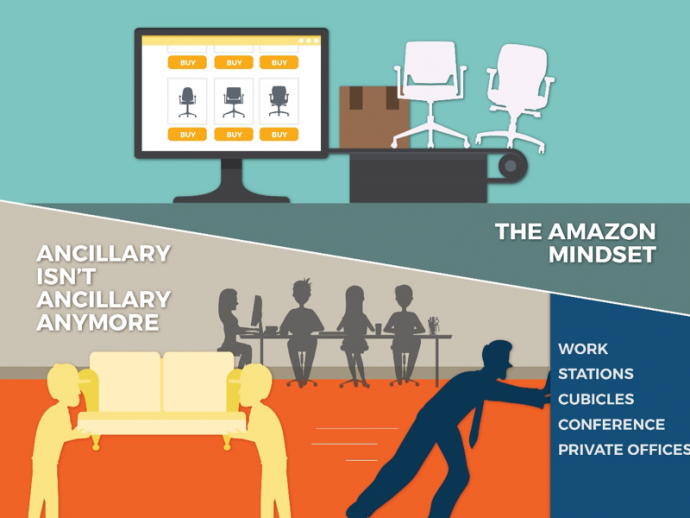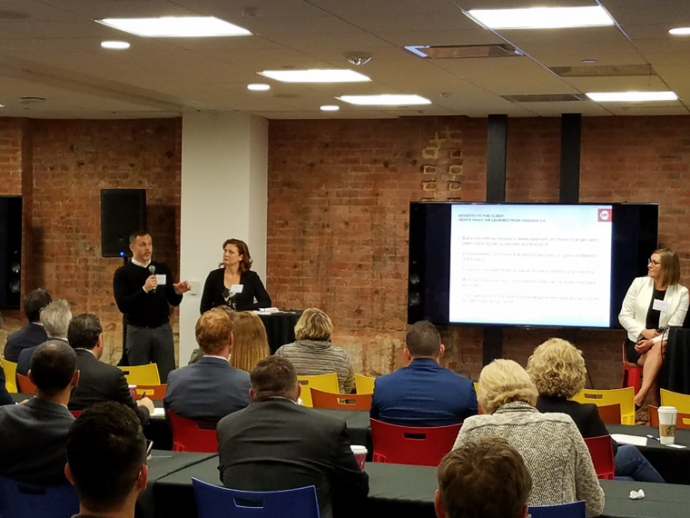The CBRE Furniture Forum 2.0 in Washington, D.C. presented a discussion of findings to date, further exploring how we can reimagine the management of the furniture bidding process.

A full house at 7:30 AM in Washington, D.C. is a clear indicator that the CBRE Furniture Forum is resonating among the shared community of CRE, A&D, manufacturers and furniture dealers. The D.C. event on October 26th, led by Julie Deignan, Director, Furniture Advisory Services at CBRE, Amanda Schneider, Founder & Consultant at Contract Consulting Group (CCG), and Suzanne Maynard, Partner Contract Consulting Group along with a panel of representatives from all four constituencies. The event provided a lively discussion of the findings to date of the teams assembled in Chicago and D.C. to discuss issues around the contract furniture bidding process. As previously reported, this has been an ongoing project, initiated in Chicago earlier this year. As interest has grown, momentum to identify and develop actionable ideas that can be implemented to further the efforts and bring better understanding, cooperation, and process improvement that will benefit all stakeholders in the industry.
As the event kicked off, Amanda noted that it’s clear that how we work is changing, but the furniture purchasing process has not. It’s universally acknowledged that the system is broken, yet to date, there have been limited attempts to reset the process and bring up to speed with how business is done today.
The group shared ideas with the audience on how to go about moving forward with the efforts of the CBRE Furniture Forum, and the research and analysis of the Contract Consulting Group.We have highlighted here some of the comments from the discussion.

“There’s a considerable lack of transparency in the process, but there is not one single path that will work universally for all participants.”
– Kim Sullivan, Senior Associate, Workplace Design, and Consulting at Gensler
“Dealers always say ‘yes’ to set a level of service.”
– Sybil Freedman, Director at CBRE, Inc.
“The complexity of the process is overwhelming and is ready for disruption.”
– Bob Fox, Founding Principal of FOX Architects
“There needs to be more education among thought leaders and end users.”
– Jud Buchanan, Principal at Washington Group Solutions
“Outside the battlefield, outside of the daily project chaos, there has to be a better way. It takes courage to try something different.”
– David Noel, President, MOI
“We need to get focused and collectively work to understand each other’s processes.”
– David Corsones, Regional Sales Director at Herman Miller
“We need to learn all the roles of the participants in the process, thus, the need for education, to enhance the experience for the end user.”
– Barbara Nolan, Principal at Barbara Nolan Inc.
In today’s business environment, there are multiple players that all have a vested interest in how furniture is selected, specified, and procured. The layers of responsibility between the end user, the A&D team, corporate real estate, large and small manufacturers, and furniture dealers all play a part. These roles vary depending on the type and scale of engagement.
In the follow-up to the previously referenced article in which we noted that the title of this endeavor was changed to “Creating a Better Client Outcome,” one point of agreement among all participants is that the key to doing so is that it’s “all about the team.”
This led to the robust conversation on what would make up the ideal team, and how that may vary from project to project, as others agreed that there will never be a “one size fits all” solution. The goal of the Furniture Forum is to achieve a cohesive menu of options to inform how we can best manage to develop teams based project requirements at any particular point in time. This resulted in some commentary on the world we exist in today, and how that creates drivers for change in the industry:

“We are in an Amazon mindset – it is now about how quickly you can deliver a project.”
OK, we all know there is no Amazon Prime for executing a complicated furniture specification, order, and delivery process!
“Ancillary furniture is not just ancillary anymore.”
As workspace design evolves, there are requirements for more variety and types of furniture. The big decisions are not just for basic office furnishings, but will for a variety of activities and configurations. We see that these products now consume 50-60% of project budgets.
Additional layers of product selection and decision making increases the complexity of the work, more vetting of product, perhaps more layers of explanation engagement with the end users. Those challenges were commonly referred to and were borne out of ongoing research and interviews with clients/end users about their experiences with the furniture selection process.

Shedding some light from the dealer point of view, David Solomon, Managing Principal, Solomon Coyle LLC noted that we are now in a client-centric business environment – this is not just about office furniture anymore. Today, dealers need to be more of a specialty contractor and perhaps consultants – in addition to their role as a vendor of products. The value-add of bringing furniture dealers on early in the project team development phase, is that they are the experts and can speak to more than just the aesthetics or pricing of the product.
As furniture can typically be the second largest spend on a project, early involvement can enhance the decision making process by providing pricing, vetting budget issues, assisting in value engineering, and assisting with space planning. All of these elements can provide risk mitigation on many levels. Vetting these problems can alert teams to difficulties that can be averted and resolved earlier in the process. Clients reap the benefit where costly changes can be avoided.
The consensus among the panel centered on shared frustrations that are now leading in the direction of where concrete measures can be taken to pave the way to better processes. Here are some of the “pain points” previously identified and how the panel offered possible solutions:
From the Chicago and DC Panels:
- “Pricing is confusing.”
- “What is list price, and does it mean anything?”
- “The process makes no sense.”
- “Communication can be a challenge. Who is in charge? The Architect/Designer? The Project Manager? The Dealer? The client?”
From the client:
- “Be an advocate for me.”
- “The process is frustrating, confusing and time-consuming.”
- “The options are overwhelming.”
- “It all looks the same, how do I know what to choose?”
- “I do not feel well educated.”
- “Keep me informed.”
Opportunities to improve the process:
As a whole, the panel has identified some paths forward to remediate some of the issues identified by all parties. The following ideas are ripe for exploration as the CBRE and CCG progress in their activities to not only clarify the problems, but seek viable solutions and bring all entities together in developing new processes to improve the overall experience and operations in line with the way we do business today. The central themes are transparency and education on the processes that need to be set up.
- Elevate the role of the client, get a precise definition of their goal.
- The current industry pricing structure is at the root of many of the existing problems.
- Educate the client early in the process, align process, budget, and schedule.
- Develop a pricing process that puts the client first.
- Share the budget, know what it is up-front. Knowing this early on can help prevent multiple revisions to both selections, drawings, and pricing.
- Avoid adversarial relationships; there is distrust due to lack of transparency in the existing processes.
- Explore ways that can bring the furniture dealers into the process earlier.
- Think about new ways of maintaining competitive pricing.
- Build integrated teams from project inception.
- Clients have trouble visualizing the result, and discerning differences in product offerings.
Where do we go from here?
We need to learn from each other to better plan and execute projects. Each player has a lot to contribute yet there is little understanding of all the parts and pieces that make up their specific contributions as the system exists today. What do you do and how do you do it?
- Integrate the furniture dealers and manufacturers as trusted advisors in the design process. A better understanding of all the other factors once the product is selected that may affect project budget and schedule.
“Let us bring our knowledge to the table.”
- Lead time
- Freight issues
- Post-installation issues
- Service and warranty issues
- Design teams and dealers want to develop and ensure long-term relationships with their clients – increasing knowledge and understanding of everyone’s potential contributions may offer ways to streamline and improve the process.
“Let clients know what they are paying for.”
- Revisit the RFP process – maybe it can change and based on a system for general condition and fees, cost plus, fixed price or other models where there is more clarity for all.
- Furniture budget based on cost per SF is established early in the process but is the first item to be compromised if construction costs increase.
- Figure out better ways to plan for and manage furniture costs
- Leverage tools and technologies to make everyone’s lives easier, (software, VR, CET). All these tools can help save time and money but are useless unless they are integrated into the process at the point in time when they can have the most value.

The discussion could have continued all day, but we wrapped up with the understanding that this effort is a work in progress, and will continue with the participation of our panels and attendees at the upcoming Chicago 2.0 event on November 9th. The considerable interest in our initial activities in this process has informed ongoing plans to continue the discussion. The conclusion to date is that there are many avenues on which to proceed and that we will continue to do so in the coming months. Investigating better ways for everyone to contribute the process, developing tools to educate participants, and understanding what each entity adds to the team will go a long way to improve the client experience and project outcome.


I love the manner you conferred this. You actually have an honest grasp on what’s required to reach digitally selling alittle business. the matter is that almost all individuals recently became familiar with instant gratification, thus expect instant results from their selling efforts. the fact is, that to succeed with any style of selling, you’ve got to be consistent, deliberate and most of all, terribly patient.
This article is spot on. As one of the owners of a workplace furniture company, we have discussed bucking the trend and doing away with a list price entirely…but, we don’t want to endanger the relationship between the dealership and their client It’s a difficult path to navigate, but I agree with the findings that we’ll only get there by being transparent with one another in the best interests of the project. Our internal strategy is to encourage our dealership partners to involve us as early as possible in the project. (We provide custom ancillary furniture.) Over time, the more trust we build with our dealership partners the more comfortable they are sharing details of the project…which makes the outcome better for everyone.
Such an informative blog. Thanks for sharing the information.
Thanks for your sharing ! That is an interesting article. We are ATC Outdoor Wicker Furniture Manufacturer and we are looking for retailers for long term cooperation
This A Good Way To Appreciate The Teacher As They Put Their Efforts To Train Students. UK Dissertation Writers Appreciates The Teachers.